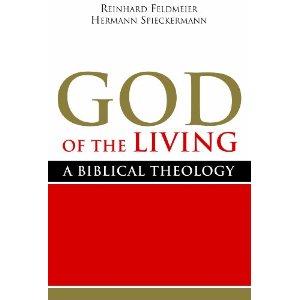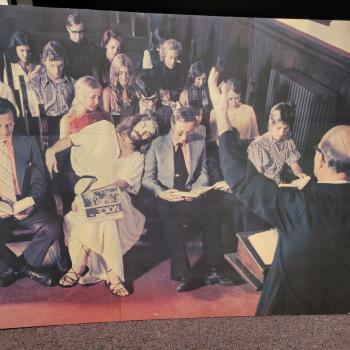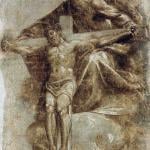(N.B. The first two reviews put up on the blog were by New Testament scholars, Hays and Hurtado, the latter two are by OT scholars).
JACK MILES
I am pleased, honored, and humbled in a somewhat disconcerting tangle of emotions to have been invited to comment on a work—God of the Living, A Biblical Theology—whose rigor and immensity tend on first encounter to provoke gratitude and something like awe in an aging sometime exegete rather than an even remote approach to critique. This work is the rigorous implementation of an insight that is beautiful in its simplicity and its fertility—namely, and I quote, that the “fundamental, without which God would not be God, is his specific desire for relationship with human beings and the world.” Professors Reinhard Feldmeier and Hermann Spieckermann do not say that God made human beings and the world because he loved them. Rather, from the fact of his having created them and the further fact of his having intensely related himself to them, they infer the desire for such a relationship. I applaud this foundational restraint on their part, and I stand in awe of the enormous edifice that they erect upon this idea as foundation.
Let me illustrate the intense internal integration that I so admire in this work by linking the sentence I just quoted, from p. 12, with another on pp. 459-460. There, after a careful review of tradition criticism regarding the institution of a New Covenant at the Lord’s Supper, with special reference to the phrase “the blood of the covenant,” the authors write:
However the tradition-critical question…is to be decided, for our examination it is important to assert, first, that the covenant idea as the God-decreed confirmation of God’s will for relationship gives Jesus’ death its meaning.”
Here are two very large claims—first, that God’s desire for relationship with humans and the world is what makes him God, and, second, that it is this desire that gives Jesus’ death its meaning. I agree with the authors in these contentions, but agreement is not just now the point I wish to make. The point is, if you will, a literary or rhetorical one: I wish to note the simplicity of the originating idea and the blend of subtlety and rigor that the work displays in its elaboration of that opening or grounding idea. Rather than a book to read, Feldmeier and Spieckermann have provided us a full curriculum of study. Their decision to make each of their chapters a self-standing essay only underscores this point. They have not written a textbook, to be sure, but any one of these chapters could be in and of itself the basis for advanced instruction in its title subject. And yet, each is adroitly, even tantalizingly, linked to the chapter that follows. There are mighty columns in this temple, each of which may be circled and inspected, but there is also the temple that they support. My first impulse upon entering this temple is, as already noted, to fall silent.
Properly speaking, a critique of this curriculum can only come from someone whose propaedeutic for the task has included all that these authors have brought to their composition of so large and deeply pondered a work. I do not claim to be such a one, and I have found myself casting about for the right metaphor to represent in advance the critique that I shall offer. Should I claim to be one of the blind men describing the elephant? No, that would be false modesty: I know too much to be called blind. I see myself rather as like the little boy who one frosty night in St. Petersburg threw a snowball at the Winter Palace. He had a good throwing arm, and he hit what he was aiming at, but what is a snowball to the Winter Palace?
The target at which I shall aim my snowball this morning is the difference between a theological and a literary appropriation of God as the Bible presents him. First, however, I want to preface my remarks with compliments to the publisher for making this important work available in English in an edition so meticulously produced (I have found so far, exactly one typo) with Greek type as well as with roman type festooned as the occasion requires with a swarm of diacritical marks. The production of any book is, from the publisher’s side, and I speak as a former publisher, an endless array of opportunities for something to go wrong. Der lebendige Gott presented much more than the usual array to Baylor University Press, and, gentlemen, we are in your debt.
I should also like to single out for praise the translator, Prof. Dr. Mark E. Biddle. Translation involves making crucial choices about crucial choices already made. By that I mean that when a writer in the source language has thought long and hard about which word to choose and when there is no exact equivalent for that word in the target language, the translator—Dr. Biddle in this instance—is forced to choose among equivalents that are each inexact in its own way. I have not consulted the original German for God of the Living beyond the title and subtitle, which are reproduced on the copyright page. But just there I immediately discern two such choices—the choice not to translate Der lebendige Gott as The Living God but as God of the Living and, in the subtitle, not to translate Einführung in die biblische Gotteslehre as Introduction to the Biblical Doctrine of God but simply as A Biblical Theology. I do not mean even for a moment to find fault with these choices. I know without ever asking that serious discussions took place about what title to give this book in English, and I can imagine good reasons for the title settled on.
Having paused long enough here at the start to note the scope of the undertaking itself and express my appreciation to the translator and the publisher as well as to the authors, let me circle back to elaborate slightly that the target for the snowball I promise lies at the intersection between, on the one hand, the biblical doctrine of God, with reference to the community of believers who know God only as they are known by him—by the Church, if you will—and, on the other hand, the biblical concept of God as it may be appropriated and employed by a community—the Republic of Letters, if that Enlightenment expression may be admitted—that knows him only as it knows literary characters in other books. In German, if I dare gamble at putting this distinction into that language, my target lies at the intersection between die biblische Gotteslehre and die biblische Gottesvorstellung.
To develop the small point I hope to make, I have chosen to exploit the excellent scriptural index that the Baylor University Press edition includes. Experience teaches us that all Bible critics, try as they might to do otherwise, do end up favoring a canon within the canon. Certain passages they privilege, others they accommodate sparingly or pass over in silence. So it must be. I note the fact as inevitable rather than culpable.
And presuming this to be the case for Feldmeier and Spieckermann as well, I thought it might be instructive to choose a passage of particular importance to them, a passage to which they find occasion to refer with greater than average frequency, to follow their employment of it through the discrete discussions of their table of contents, and to reflect on the results of this little inquiry in the context of the rest of their biblical citation as it may be discerned from the scriptural index.
The passage I propose to use for this purpose is Matthew 5:38-48, and clarity will be served, I think, if I quote the full ten verses in the Jerusalem Bible translation:
‘You have learnt how it was said: Eye for eye and tooth for tooth. But I say this to you: offer the wicked man no resistance. On the contrary if anyone hits you on the right cheek, offer him the other as well; if a man takes you to law and would have your tunic, let him have your cloak as well. And if anyone orders you to go one mile, go two miles with him. Give to anyone who asks, and if anyone wants to borrow, do not turn away.
‘You have learnt how it was said: You must love your neighbour and hate your enemy. But I say this to you: love your enemies and pray for those who persecute you; in this way you will be sons of your Father in heaven, for he causes his sun to rise on bad men as well as good, and his rain to fall on honest and dishonest men alike. For if you love those who love you, what right have you to claim any credit? Even the tax collectors do as much, do they not? And if you save your greetings for your brothers, are you doing anything exceptional? Even the pagans do as much, do they not? You must therefore be perfect as your heavenly Father is perfect.’
In this ten-verse passage, two verses are of salient importance to Feldmeier and Spieckermann. The first is 5:45—“In this way you will become sons of your Father in heaven, for he causes his sun to rise on bad men as well as good, and his rain to fall on honest and dishonest alike”—which makes its first appearance in their foundational and magisterial second chapter, “From Lord God to Father God.” Whatever else this passage might seem to say, for them it is supremely about divine fatherhood. The second verse they find of signal importance, which I quote now again in their own translation of it (p. 79), is: “Now, be complete, as your heavenly Father is complete.”
Now, here is how they state the connection between divine fatherhood and the nonviolence that has become, for the world, Jesus’ signature teaching and the real sensation in the passage as a whole. They write:
This saying [“Now, be complete, as your heavenly Father is complete”] follows the demand to love one’s enemy, which is justified by God’s care even for the evil and the unjust (Matt 5:45). The disciples should reflect this unconditionality of the divine love—this is the intention of the concept of completeness which the Evangelist has probably inserted here—in their love even for their enemies and persecutors (Matt 5:44) in order to be children of God.
The human race are not all children of God simply by virtue of being human. The status of child of God must be earned by loving as God loves. The authors are struck most by the (almost entirely redactional) reference to God as “your (heavenly)Father/Father in heaven,” by which the Evangelist connected the various components of the Sermon on the Mount to one another, in order to make it clear that Jesus’ followers are included in the relationship between Father and Son by the relationship with God initiated by the Son of God and that, thereby, they become children of God themselves.
On p. 90, later in “From Lord God to Father God,” they cite 5:45 and 5:48 again as they declare that “The point of Christology is soteriology.” As children of God, believers are required to imitate God’s mercy by loving their enemies. “The associated assurance, however, is supremely important. As children, believers are heirs…of the Father who assures his child, “Child…whatever is mine is yours” (Luke 15:31).
Finally, for the last time in “Part One: Foundation,” they cite 5:45 again in the fourth and final chapter of “Foundation”—namely, the chapter entitled “The Loving One.” In that discussion, God’s prevenient love is of a piece with his prevenient mercy in the establishment of the Father-child bond: His disciples are required to be merciful in response to his mercy and loving in response to his love.
In “Part Two: Development,” the centrality of the father/child relationship is subsequently instanced, each time with a new emphasis, in several chapters, beginning with Chapter 7, “Word and Creation,” the first of these chapters. Here, 5:45 reappears as witness to the economy of God’s paternal care for his creation, a creatio continua to which his children can only respond by caring for their enemies as he does. Paternity is prominent again, in Chapter 9, “Justice and Justification,” as 5:43-48 are cited in witness to the claim that rather than any form of “’works righteousness’ gained by one’s own action,” loving one’s enemies “is constitutive of a relationship to God.” Matthean righteousness inheres thus in what is done “to conform to the God who, through Jesus as Immanuel “God with us” (Matt. 1:23), has become ‘our heavenly Father’.”
In Chapter 10, “Forgiveness and Reconciliation,” 5:45 appears in a footnote linking it to the Eucharist—always referred to here as the Lord’s Supper—as a ritual of reconciliation. Jesus established a new covenant with his disciples just as they were about to betray him, forgiving them thus in advance. “Consequently, in the Lord’s Supper, the community may celebrate Jesus’ death as the foundation of continuing reconciliation with God, and it should relay this reconciliation to others” (p. 323). The connection of this to 5:45, in the authors’ words, is that “God’s forgiveness applies only to those who reflect the forgiving God and, thus, become “sons of God” (Matt 5:9, 45)” (ibid.). Once again, the discourse circles back to the motif of fatherhood and to the conditions that must be met for the attainment of sonship.
Chapter 11, “Commandment and Prayer,” devotes an entire subsection, “The Will of the Father: Commandment and Prayer in the Sermon on the Mount,” to the discourse of which Matthew 5:38-48 is a part. In citing 5:9,44-45, and 48 again and stressing yet again the motif of fatherhood and sonship, the authors enrich the frame around this relationship by asserting that the moral imperatives of the Sermon on the Mount are addressed not to individuals but to the community and by adding that “This relationship to God…lives by prayer” as proven by the fact that Matthew places the Lord’s Prayer—the prayer, of course, that famously begins “Our Father…”—at the center of this pivotal discourse.
Let me conclude my little catena aurea with what I believe to be the authors’ most extended direct address to this most challenging of Gospel pericopes:
“The interrelationship of commandment and prayer also determines the most radical demand in the Sermon on the Mount, the commandment to love one’s enemies. In Matthew 5:44, the Evangelist abbreviated the probably original dual parallelismus membrorum that Luke offers in Luke 6:27-28 to a single statement with the result that, now, both demands, to love one’s enemies and to pray for one’s persecutors, together constitute a new parallelismus membrorum. In this manner, he makes it clear how the relationship to the enemy cannot be excluded from the relationship to God.” (p. 444).
The logion cited tacitly from Q has four members in two pairs—“love your enemies” and “do good to those who hate you” plus “bless those who curse you” and “pray for those who treat you badly.” Matthew has contracted these to just one pair: “love your enemies” and “pray for those who treat you badly.” The result, the authors maintain, is to more forcefully insert the self-enemy relationship into the self-God relationship. They quote W. Schrage with approval: “(L)ove implies that one takes the other along before God.”
What I have tried to suggest by the preceding citation history of just this one passage within God of the Living is how skillfully Profs. Feldmeier and Spieckermann succeed in linking a Christian metaphysics—the Gotteslehre or Gotteseigenschaftslehre mentioned on their first page—to a consistent Christian ethic. They have produced an exegetical hologram in which a passage such as the one I chose—and I just chose one of many available—does not change its place but nonetheless shows itself to different advantage as the reader sees it from different angles—that is, in successive scriptural contexts. It is not, changing the metaphor, that these scholars have produced a seamless whole. There are many seams, but the appeal of the work lies precisely, as I might put it, in the beauty and sensitivity of their stitching.
And now comes the snowball.
What they have sewn together, they have sewn together extremely well, but have our esteemed colleagues left anything out? As we look at the scriptural index to God of the Living, does any pattern of omission suggest itself? Let me note a few omissions—or perhaps elisions is the better word—that strike me as potentially significant and see if any pattern comes to your mind.
Regarding the Book of Genesis, they have nothing to say about God’s destruction of the world by flood in chapters 6-8. They do talk about the Noachic covenant and the rainbow in chapter 9 (and I shall return to the rainbow), but about the destruction they have nothing to say. They have nothing to say, too, about Genesis 22, the ordeal of Abraham and Isaac.
Regarding the Book of Exodus, they have nothing to say about God’s destruction of Egypt by the ten plagues, nothing to say about the Passover and the slaughter of the firstborn of Egypt, nothing about the Exodus proper and the drowning of Pharaoh’s pursuing army. They do not find occasion to quote Exodus 15, the exultant victory song of the ransomed Israelite slaves with its refrain, “Yahweh is a warrior, Yahweh is his name.”
Though they write, “Among the biblical documents that attest in their polyphony to the vital relationship among knowledge of God, knowing God, and the doctrine of God, the book of Deuteronomy occupies special status in the Old Testament” as “almost the oldest doctrine of God” (p. 3), they pass over in almost complete silence the blood-curdling blessings and curses of Deuteronomy 28.
They are well aware of how the Deuteronomistic history extends the blessing/curse paradigm to the whole of subsequent Israelite history down to the Babylonian Exile (p. 430, n. 8), but they pass over that history itself in almost total silence. From the Book of Joshua, the authors cite only the speeches of Chapter 1; the genocidal conquest that ensues they pass over in silence, omitting even the covenant ratification at Joshua 24. The often gory adventures of the Book of Judges, not least its supremely brutal conclusion, go unmentioned. From the Books of Samuel, we hear of the royal covenant and God’s adoption of Solomon at 2 Samuel 7, but we hear nothing about David and Goliath, nothing about the counting out of the foreskins of slain Philistines, nor anything earlier about God’s rejection of Saul for insufficient ruthlessness with the Kenites. Nothing is quoted from the Books of Kings in which God, true to his word, wreaks havoc on Israel comparable to what he wreaked on Egypt, just as he warned he would do at Deuteronomy 28
One consequence of this near-total omission of the former prophets is a relative eclipse of the epic of Israel. Now, I find a relative eclipse or displacement of this sort consistent enough with the agenda of a work quite candidly and from the start offering a doctrine of the God specifically of the Christian Bible. And I would note, as I should think the authors themselves might, that I could easily lengthen this list with the mention of other books—Lamentations and Esther, to mention just two—that go uncited because they did not bear on the expositional agenda of the work in hand.
What I would draw attention to, nonetheless, and on aesthetic rather than on theological grounds is the consequence for Matthew 5:38-48 of the exclusion of the books and chapters that I have just listed, for these omissions constitute a significant suppression of attention to God’s war-likeness. The more attention is given to divine war-likeness, I submit, the greater is the climactic drama of the moment when the War God of the Jews, now become a Jew himself, proclaims himself a pacifist at Matthew 5:39. Conversely, the more all attention to prior divine violence is suppressed, the weaker the dramatic power of this truly revolutionary passage in Matthew.
With more attention to the violent side of the Lord God might come, naturally enough, more attention to the violent side of Jesus himself. Take, for example, the following from the Matthaean apocalypse, another passage omitted from the work we have under discussion:
If, then, they say to you, “Look, he is in the desert”, do not go there; “look, he is in some hiding place”, do not believe it; because the coming of the Son of Man will be like lightning striking in the east and flashing far into the west. Wherever the corpse is, there will the vultures gather.” (Matthew 24: 26-28; Jerusalem Bible)
“Wherever the corpse is, there will the vultures gather” is a heart-stopping line, a line of utterly brilliant blackness, but it is just the kind of logion that, as I read them, Feldmeier and Spieckermann are simply disinclined to linger over. Or, similarly, from the same vision:
“As it was in Noah’s day, so will it be when the Son of Man comes. For in those days before the Flood people were eating, drinking, taking wives, taking husbands, right up to the day Noah went into the ark, and they suspected nothing till the Flood came and swept all away. It will be like this when the Son of Man comes. Then of two men in the fields one is taken, one left; of two women at the millstone grinding one is taken, one left.” (Matthew 24:37-41; Jerusalem Bible.)
Since Feldmeier and Spieckermann omit the Noachic catastrophe itself, they are consistent, perhaps, in omitting its Messianic analogue, but this and the earlier mentioned omissions are not without consequence for the aesthetic impact of the God-portrait being drawn.
The consequence, in my estimation, is analogous to the subtraction of black from a painter’s palette of colors. Something is gained in brightness when there is no black in a painting, but something is lost in contrast, depth, and drama. God as a being unfailingly just, desirous in the first instance always and only of a relationship with the creatures that he will create in his own image and with the world that he will provide for the living of their human lives—such a God is less compelling in literary terms than God as a being not so entirely under his own control as all that, a God who may even, however scandalously, relish taking unsuspecting human beings by surprise or inflicting collateral damage on the vulnerable: “Alas for those with child, or with babies at the breast, when those days come! Pray that you will not have to escape in winter…” (Matthew 24: 19-20). In phrases like these, Jesus seems to speak of disaster that he can foresee but cannot claim to control, and the language is stronger and more arresting for that very reason.
Citing Nathan Söderblom, Rudolf Otto, and especially Mircea Eliade for the disparagement, Feldmeier and Spieckermann write:
“The dynamistic and phenomenological understanding of religion that has dominated in recent centuries, which proceeds from a primarily impersonal numinous power associated with the holy, offers little illumination for Old Testament concepts of God’s power. Here, God does not elaborate his power self-referentially but in relation to his people primarily to deliver, but also to judge” (p. 149).
I beg to differ, or at least to distinguish. I believe that most of the time, yes, what they allege is true of God but that some of the time, it is false. There are scattered but vivid moments in the biblical text when God’s dynamism passes from him involuntarily; in such moments, his power is indeed self-referential in that he himself does not direct it to any human referent.
Allusion is repeatedly made to divine power in this sense at Exodus 19, to name one example. I draw your attention in the following quotation to the recurrence of the verb to break out (Hebrew paratz):
Yahweh said to Moses, ‘Go down and warn the people not to pass beyond their bounds to come and look on Yahweh, or many of them will lose their lives. The priests, the men who do approach Yahweh, even these must purify themselves, or Yahweh will break out against them. Moses answered Yahweh, ‘The people cannot come up the mountain of Sinai because you warned us yourself when you said, ‘Mark out the limits of the mountain and declare it sacred”’. ‘Go down,’ said Yahweh to him ‘and come up again bringing Aaron with you. But do not allow the priests or the people to pass beyond their bounds to come up to Yahweh, or he will break out against them.’ (19:21-24; Jerusalem Bible). In this passage, Yahweh speaks of himself in the third person rather than the first whenever reference is made to this “breaking out,” and the passage gains immensely in literary power as the impression is created that he is beyond his own control.
Divine power “breaks out” in the same menacing, unannounced, and unforeseen form at 1 Chronicles 13 as the Ark of the Covenant, no longer in Philistine hands, is being brought from Kiriath Jearim to Jerusalem on a oxcart newly made for the purpose. At a certain moment, the movement of the oxen makes the cart tip, an Israelite named Uzzah reaches out his hand to steady the ark, and the anger of God blazed out against Uzzah and he struck him down because he had laid his hand on the ark, and he died there in the presence of God. David was displeased that Yahweh had broken out against Uzzah, and that place was called Perez-uzzah as it still is now (1 Chronicles 13:10-11).
Historical criticism may see here a buried polemic against the use of any wheeled vehicle for the transport of the Ark, for the instructions for its transport given in the Book of Exodus stipulate a litter. A chariot is a kind of a cart, and the Israelites were neither charioteers nor carters. Be that as it may, Uzzah’s intentions here are clearly benign, but God’s anger is, as it were, combustible—susceptible to “breaking out”—upon any human touch. The occasion thus need not be either one of deliverance or judgment, or so I would maintain against the better judgment of our distinguished visitors.
Where, finally, does this bring us?
It brings me, personally, to a moment of reminiscence. I all but never teach Bible to children. I am too indulgent to be a good teacher, I think. But on one memorable occasion, I was drafted to teach Sunday school on a Sunday when the lesson was the Noah story. In the instructions for the teacher that were provided me, I was urged to stress the rainbow rather than the annihilation of all the world’s animals because “children have pets and might be troubled by the thought of God as a pet-killer.” I laughed as I read that line, but on later reflection, I saw that the joke was on me, for I, as an adult, had as much reason as any child to be troubled by the thought of God as an indiscriminate animal-killer, let alone a mere pet-killer. The initial comic reaction came from my having my own inattention to the text taken by surprise. Moreover, the church had and has every right to determine not only which portions of the Bible it shall read, and when, to its children but also which portions of the Bible it shall stress, and when, for its adults. As a church member, I take the position toward the Bible that Jesus took toward the Sabbath: “The Bible was made for man, not man for the Bible.”
As an adult Christian, I maintain that whether I regard my identity as a writer or a critic or a citizen or a parent as subordinate to or subsumed by my identity as a Christian is up to me and that my choices in that regard will quite properly vary from one situation to the next. At times, I may and do regard my identity as a Christian as subordinate to and subsumed by my identity as a citizen. Just which identity shall be host and which shall be guest depends at any given moment upon the moment itself. It is against that background that I can propose the authenticity of a Gottesvorstellung, an image or concept of God, suitable for the purposes of art and distinguishable from the Gotteslehre carried forward by the church in communal reflection upon its life as church in the light of the Bible.
For the Bible, in short, no longer belongs to the church alone. Our Christian Bible is jointly owned, in the first instance, with the God’s People the Jews, who read it in their order and to their own purpose. It is jointly owned as well with Western Civilization, which employs it to other, un-Christian but not for that reason alone unworthy or repellent purposes. Works written to purposes not one’s own can often be the more stimulating for that very reason. Yet whether for biblical theology in the service of the church, whether for academic theology in the service of historical understanding, or whether, finally, for extra-ecclesiastical, extra-academic aesthetic appreciation of a sort that Profs. Feldmeier and Spieckermann might regard as of the spirits rather than of the Spirit, God of the Living, A Biblical Theology is a book that we shall be reckoning with for many years to come.
















